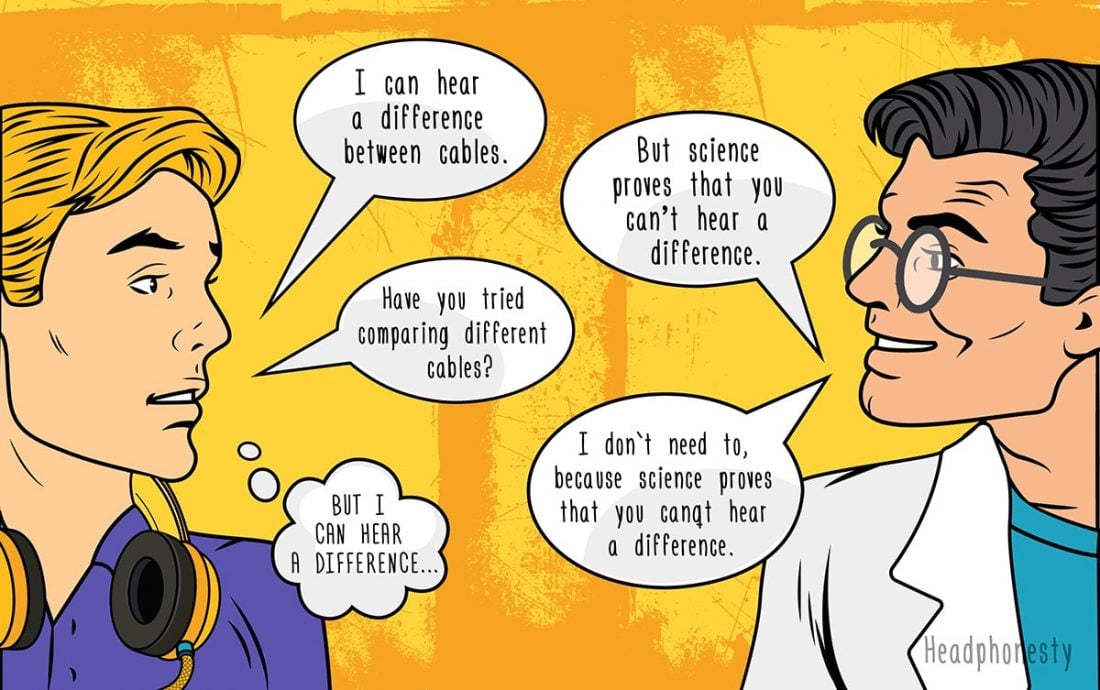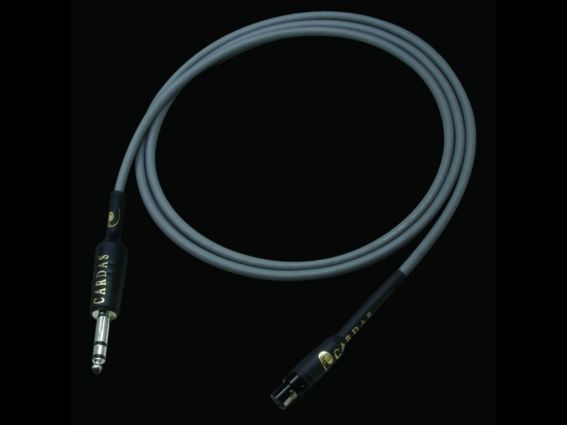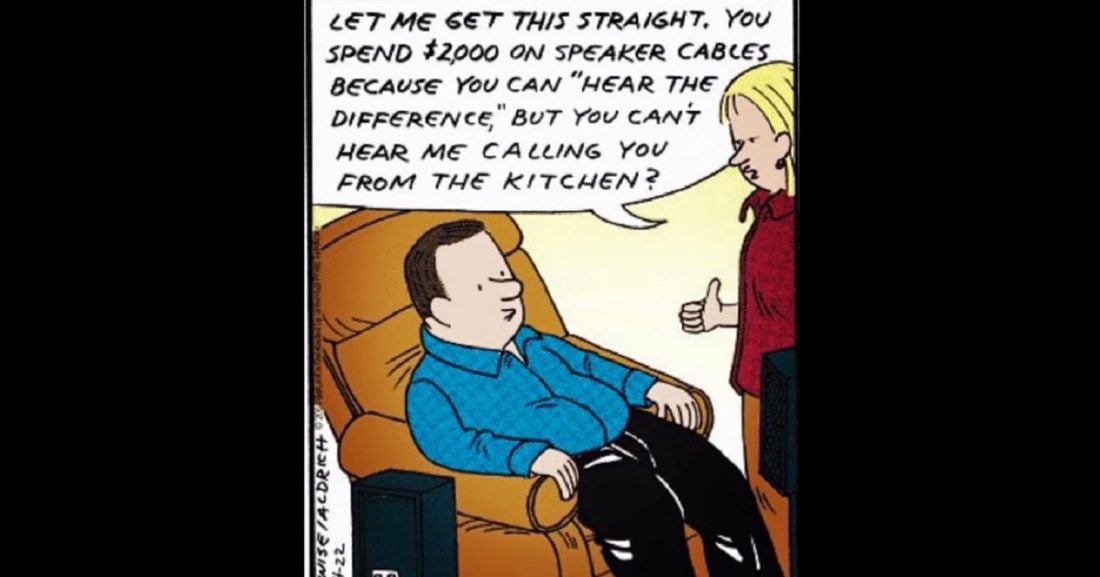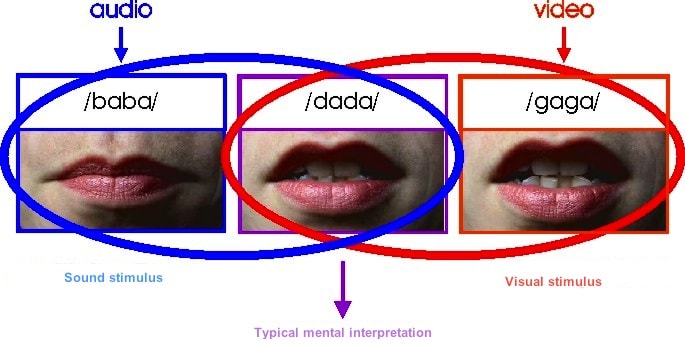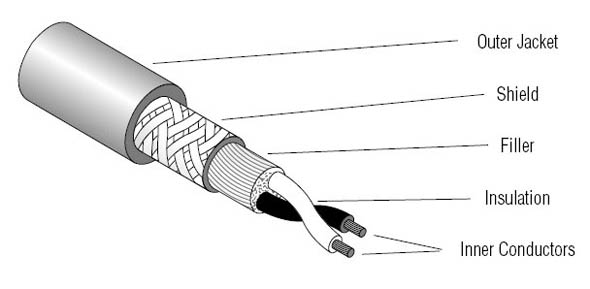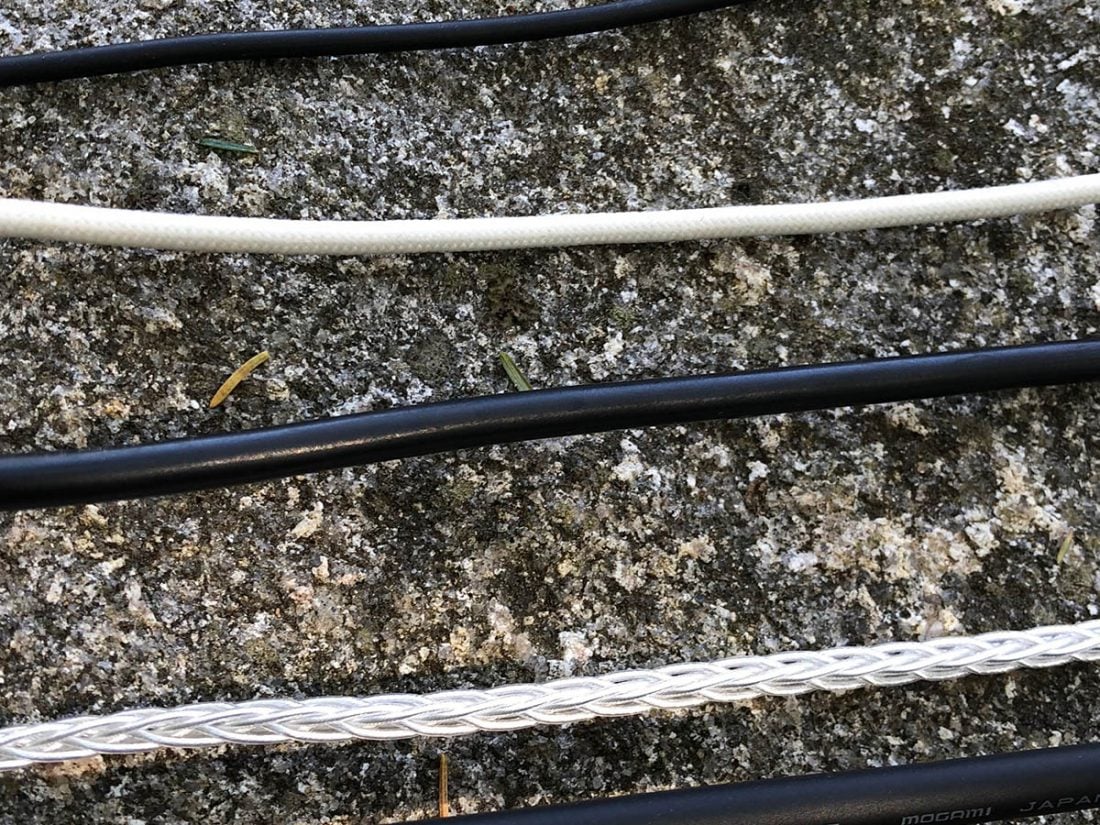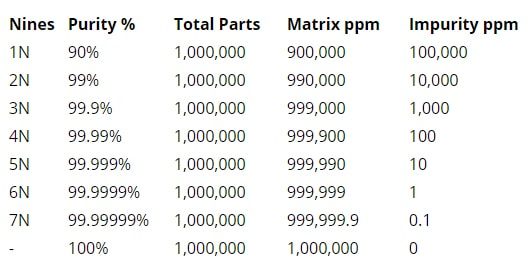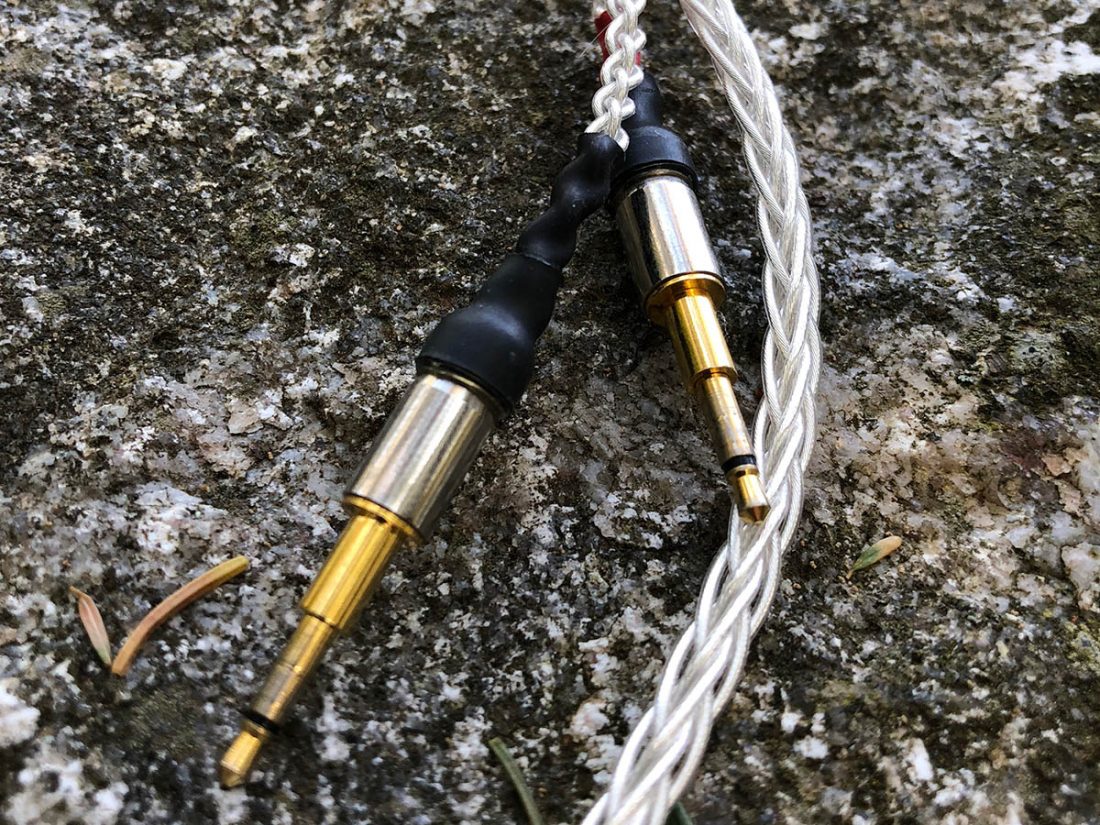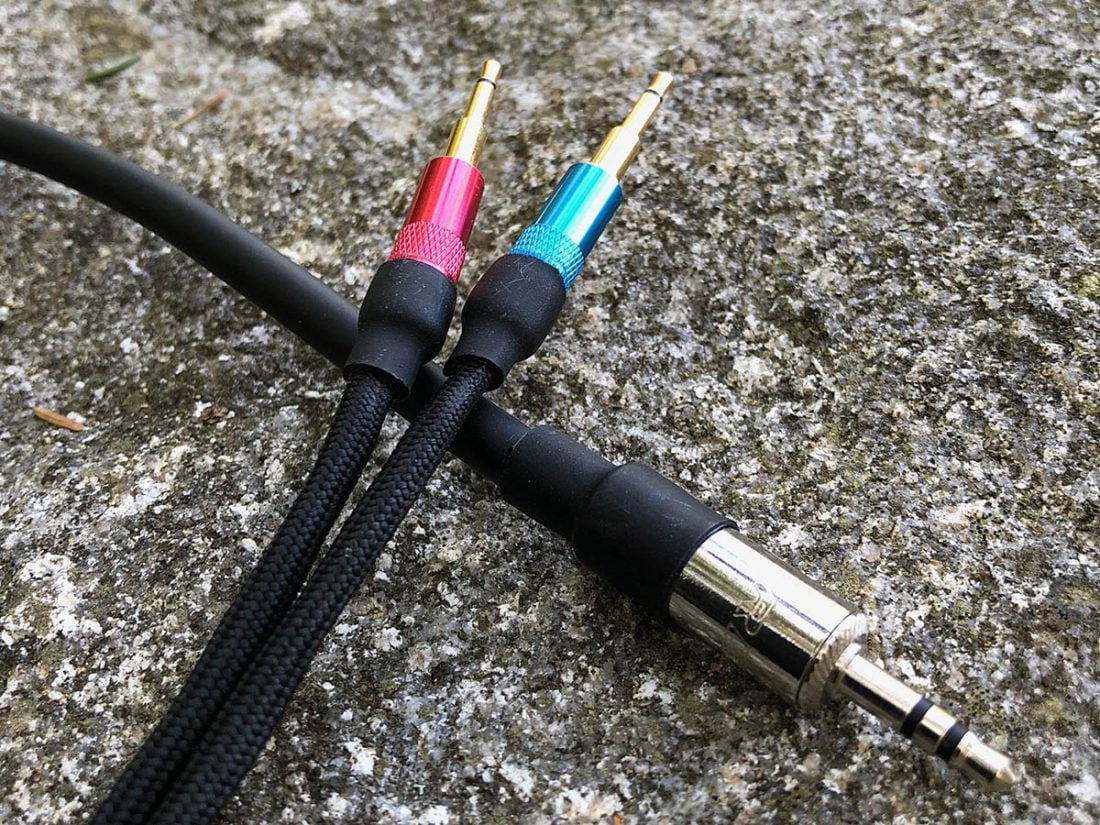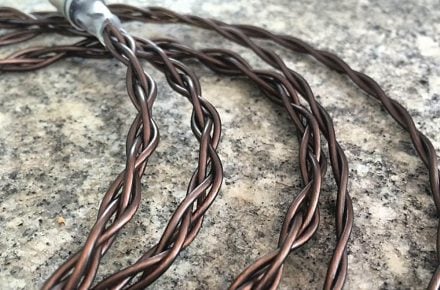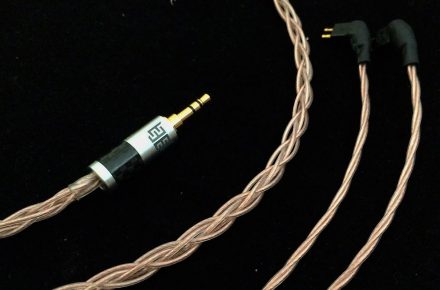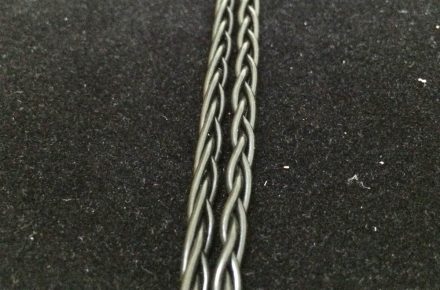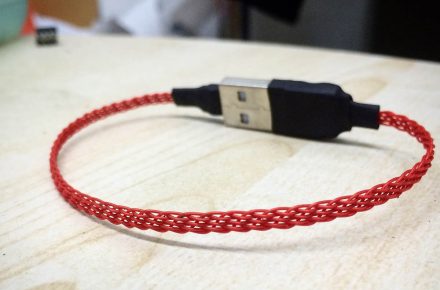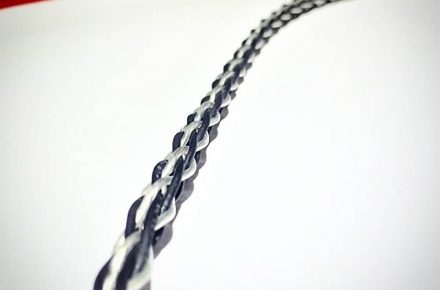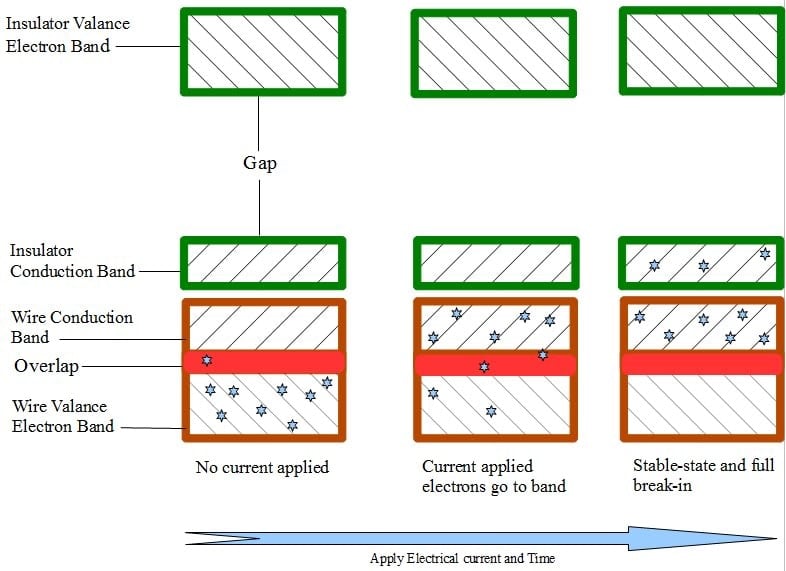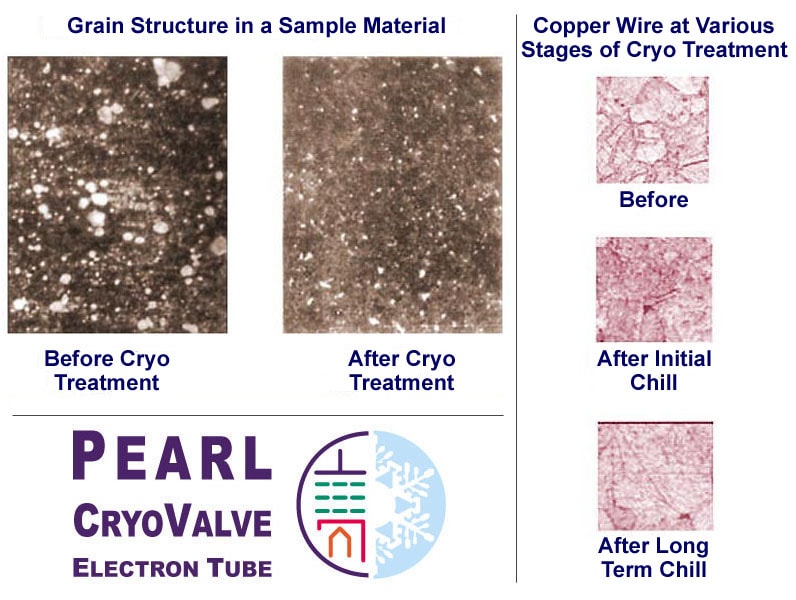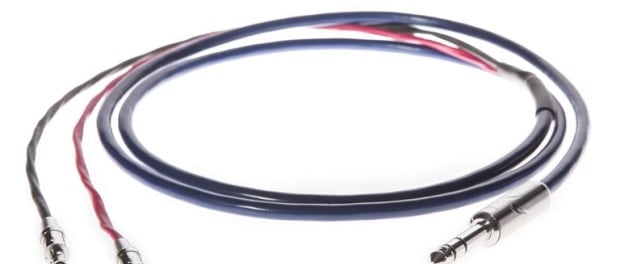Typically, the arguments would get stuck in a loop, similar to the one below:
Please note that this article will focus primarily on analog headphone cables (and extension cables), rather than digital connections (such as USB or Lightning). With that said, wireless Bluetooth headphones will only be impacted when connected with an optional analog detachable cable.
Claimed Improvements in Expensive Cables
I think it is important to note that ‘expensive’ doesn’t necessarily mean ‘high-end’. Cost (perhaps) should be an indicator of the quality of the cable’s materials and design, but it doesn’t always perfectly align. It is certainly possible to create high-end cables, with the use of premium materials at minimal cost – just ask a Do-It-Yourself-er. It is often impossible to find out if expensive cables are indeed constructed from high-end materials. That is, unless you destroy the cable as the materials used and construction of it are typically hidden underneath the outer sheath. Have you ever read an audio review that described improvements in ways such as “better micro-details”, “has no skin effect” or that the sound is “smoothly textured”? Much of the cable debate revolves around these sorts of tenuous descriptions of sound, which by their very nature, are extremely difficult to prove or disprove. When describing how headphones perform, most readers generally understand what “extended treble” or “lack of deep bass” sound like. These results are clearly visible using measurement tools. However, when describing the source or amplifier, the terms get hazier with descriptions like “grainy”, “shallow”, “pure”, or “accurate”. Cable performance narratives go further down this obfuscated path, with claims of “detailed”, “musical”, “rich” or “focused”. Without measurements to support the descriptions, fuel is added to the debate.
Chapter 1: The Spectrum of Belief
Fundamentalism defines a strict devotion to a set of beliefs. The cable debate represents a fundamental impasse between the scientific evidence-based objectivists, and the experience belief-based subjectivists. Putting aside the clear similarities to the classic Religion vs Science debate, we shall hereby refer these two opposing viewpoints as the “Skeptic“ (cables make no difference) and the “Believer” (cable differences are audible) for our discussion.
The Skeptic
It is not as simple as saying that all wires measure the same, and therefore, should sound the same. In fact, the Skeptic is quick to point out that it is quite possible to measure differences between cables, however, they contend that the differences are inaudible. From an academic perspective, a “better” cable may be able to offer an improvement in measurements, but the improvements are so minuscule as to be meaningless in use. The Skeptic proclaims that they only have confidence based on proven scientific evidence and testing. The most common evidence cited involves the claim that no one has ever passed a proper ABX test of cables.
What is an ABX test?
An ABX test, unlike a simple blind test, is a test whereby the listener has to listen to a total of three samples, i.e. Sample A, Sample B (known samples to the listener) and Sample X (unknown sample to the listener, which is selected at random from either A or B). The listener would then have to identify X as either A or B. A thread on Head-fi.org entitled Testing Audiophile Claims and Myths does an excellent job of collecting and discussing 50 blind audio tests.
Ugly Side Of The Skeptic
The Skeptic (unfortunately) may present a distinct ‘holier-than-thou’ approach and, habitually, isn’t interested in considering alternative viewpoints. When discussions revolve around someone purchasing expensive cables and reportedly hearing an improvement, these Skeptic may imply that the purchaser has wasted their money and that the differences they hear are solely a result of purchase justification and expectations. While the Skeptic claims to be objective, many of the discussions are far from impartial, neutral, or dispassionate.
The Believer
On the other side, you have a group of passionate folks who would swear that they are able to hear a difference in sound reproduction between cables. The Believer often exhibits the following traits:
Having years of experience in the audiophile community; Having the skills that are required to analyze the quality of what they hear; and Claims that they can tailor cables-and-headphones matching to achieve the sound they desire
However, the Believer can offer no empirical evidence to confirm their beliefs.
Ugly Side Of The Believer
So the question on hand is how does the Believer have so much confidence in the face of ambiguous, subjective and non-measurable results? When challenged, this group tends to be quick to ask what the other side has for playback equipment. If it is not absolutely the top-of-the-line gear, they would then imply (or state) that the equipment simply isn’t good enough to hear an improvement. The Believer tends to roll their eyes at blind testing or analysis, which is supported by the Skeptics. They have faith in what they have experienced and do not want to be persuaded otherwise.
Chapter 2: Why The Cable Debate Gives Audiophiles A Bad Name
Ignoring an individual’s claim that they can hear a change in sound, simply because the listener is unable to provide scientific proof or an easy-to-digest explanation, may be short-sighted. The explanation may be missing, but the experience can still be valid. Just because something is currently a scientific practice doesn’t mean it is absolute truth. We use science to predict future events based on past experience, however, science is always evolving to create a more accurate prediction of what is true. Blind and ABX testing are valuable tools used to scientifically test for perceived differences, but testing is only a subset of all the possible scientific methods. We have to remember that we do not know everything. Hearing perception may be beyond current measurement tools. The probability may be low, but it is possible that we might not even be measuring the right things. Approaching the discussion with patience, rather than with scorn and polarized conclusions, benefits both sides of the debate. Unfortunately, the poor behaviour, refusal to listen to opposing views, and dismissive sniping so often exhibited by these two groups can give the term “audiophile” a bad reputation.
Chapter 3: Why do Some Listeners Report Hearing Differences Between Cables?
It is important to note that hearing a ‘difference’ does not equate to hearing an ‘improvement’. All too often, any perceived difference is interpreted as improvement in sound, especially when equated with high-end equipment and cables. From the Skeptic point of view, if a cable is designed to function properly, any perceptible change only serves to reduce the functionality to below an acceptable level, and any improvement above the acceptable level is inaudible (even if it is measurable). It is possible that the difference heard is attributable to the listener, rather than the cable. If one accepts the blind and ABX testing results, the explanation may be attributed to listener bias (expectation, placebo, purchase justification) or psychoacoustics (the study of the perception of sound). Psychoacoustics studies the ear’s limitations in sensing sound, including:
Hearing Range – the audible range of frequencies. Typically described as 20-20,000 Hz, although this varies between individuals and high-frequency sensitivity is lost with age. Absolute Threshold – the minimum audible sound level of a tone with no other sound present. Masking – the perception of one sound is affected by the presence of another sound.
Listening is a complex process. Our brains discard much of the sensory input, and use pattern matching, memories and experiences to interpret the huge amount of information received. This is not an infallible process and our brains can be fooled into hearing (or seeing) things that are an illusion. One famous example is the McGurk Effect.
The Perception of Sound
This McGurk Effect video from the BBC explores when the visual cues of speech do not match what you hear. The brain prioritizes the visual cues over the auditory input and you would hear a different sound than the one being played. Regardless if it is completely applicable to perceived cable sound changes or not, it is a fascinating phenomenon, and I would recommend you to watch the link above. A listener may indeed sense a difference due to how our brains perceive sound (and music), which is more than simply hearing. What the listener experiences is an amalgam of all their senses, emotions and experiences. This explains the unconscious preconceptions a listener brings to a listening test, or to a swap of cables. – BBC Two
All in the mind
It impacts how everyone perceives music and why two individuals can listen to the exact same equipment and report different findings. This could also apply to how a single individual listening at a different time or location can experience different results. There is no dishonesty or deception involved, it truly is “all in the mind“. Unconscious belief is enough for the listener to hear or to not hear a difference.
Audio Illusions: Yanny or Laurel
A couple of audio illusions are making the rounds on social media. Do you hear Yanny or Laurel? How about Brainstorm or Green Needle? In a recent Telegraph interview with Valerie Hazan, she explained why we could hear different things when listening to the same sounds: There are several good reasons that could substantiate the Believers’ claims in being able to hear a difference between two cables, i.e.:
It is reasonable to expect a difference as many credible people have reported hearing differences The listener may have heard a difference between cables in the past The listener may have experience and training on discerning small audible differences The listener may not have discarded the Skeptic’s point of view, but believes current testing methodology is not enough to explain the audible differences
Expectation Bias
Expectation bias is often mentioned when talking about the Believer. However, it works both ways. The Believer may expect that a more expensive cable will sound better, and the Skeptic may expect that all cables will sound the same. These expectations lead each group to hear “improvements” or “no difference at all”, depending on their bias, and to dismiss anything that doesn’t fit their own expectations. We’ve covered what may not be real, so let’s move on to the facts. What’s inside headphone cables?
Chapter 4: Anatomy of a Headphone Cable
Headphone cables vary greatly in how they are made and the types of materials used. In essence, there are two wire conductors per headphone driver, which is surrounded by an insulator and terminating into a headphone jack at the end. On the headphone cup side, there may be additional termination jacks, or the wires may enter the cup and be soldered directly to the driver. There is an inexhaustible amount of opinions about the impact on sound quality of every aspect of cable construction and materials. The type of metal, properties of the insulation, shape/size/braid of the conductors, type of solder, etc. are all widely debated! With this many variables, it is no wonder that there is no clear consensus on the best headphone cable. Headphone cable construction also includes the physical aspects of durability and usability. In general, this encompasses::
Pliancy – the flexibility of the cable; how easily it bends. Strain Relief – the transition from the cable to the rigid connector – intended to prevent load applied to the cable from being transferred to the connection. Memory Retention – the cable retains its shape when manipulated. Microphonics – sound transferred to the headphone from touching or manipulating the cable.
Cable Materials
Headphone cables and jacks are made from materials such as copper, silver, gold, or rhodium. Connectors may be solid (same material all the way through), or may be plated over cheaper metals such as brass. Silver plated copper wires are also becoming more common as a cheaper alternative to solid silver wire. Of course, copper remains as the most common wire material as it has the highest electrical conductivity rating of all non-precious metals.
Copper Wire
Headphone cables are most commonly made of strands of very thin braided/twisted copper wires, as it is more flexible, better resists damage due to twisting/vibration, and has essentially the same conductivity as a single strand conductor. Copper purity is usually discussed in terms of #-nines where # is the number of nines in the measurement of purity. 4-nines copper is 99.99% pure, whereas 6-nines is 99.9999% pure. The electrical conductivity of 4 and 6-nines copper is almost indistinguishable at ambient temperatures. A very common feature touted in copper audio cables is the use of Oxygen-Free Copper (OFC) that has been refined to reduce the level of oxygen in the copper to 0.001% or below. C10100 copper, a special variant, is a highly refined (and very expensive) copper that is sometimes used in premium audio cables. It has the ability to remove any silver impurities and reduce the oxygen to 0.0005%. However, it yields only a one percent higher conductivity than standard OFC. This is often a topic of debate – if oxygen content or impurity removal is in any way audible.
Metal Colors and Its Impact on Sound
I would be remiss to not comment on the typical descriptive terms applied to the materials used in cables and connectors. A quick search on popular audio forums will turn up descriptions like: Note that that rhodium and silver are associated with terms like bright and shiny, while copper and gold are described as having earthy and warm color. Often, the brighter materials are equated with a brighter sound, whereas the warmer colored materials with a warmer sound. Is this a case of our eyes influencing our expectations or is it because of the sound differences long understood between brass instruments? From thetrumpetblog.com: Is it a coincidence that the tonal qualities of instruments are also linked to wires of the same color and finish? It certainly seems like there may be expectation bias at play.
Chapter 5: DIY Headphone Cables
As aftermarket cables can be expensive, curious and capable folks often would go the Do-It-Yourself (DIY) route. If you are competent with a soldering iron, creating custom headphone cables yourself can be a fairly easy and fun project. It also lets you try out high-end materials at a fraction of the cost of a commercial option. Want to see if you can hear a difference in cables, but not willing to spend big bucks? DIY is a great solution. One of the most cost effective methods of getting high-quality copper wire perfect for headphone cable construction is from 4-wire microphone cables from Mogami or Canare. I tend to use Mogami 2534 for my builds as it is high-quality, easy to use, and readily available in bulk.
Types of Cable Braids
Perhaps the most individual aspect of building headphone cables is creating the braid for the wires. The braid serves to contain the individual wires, minimizes interference and creates an attractive end product. A well-done braid elevates DIY headphone cables to professional works of art. The Ultimate Cable-Braid Resource details the most common types of braided headphone cables.
Chapter 6: Cable Science
Regardless of the type of cable, a cable length has a linear relationship with the resistance on the audio signal. Measurable differences between cables approach zero as the wire gets shorter. A perfect wire would have no measurable resistance, inductance or capacitance. In general, minimizing these three properties, and their impact on impeding the flow of electrons, is the goal of proper cable design. As long as the cable is functioning properly and can transmit the signal, the science basically boils down to resistance, capacitance and impedance in the wire (and perhaps within the terminations). Resistance in a wire results in loss of all frequencies while inductance causes losses that are proportional to the frequency. Increasing capacitance enough in relation to the damping factor can cause high frequencies to be rolled off.
Skin Effect
The Skin Effect of a conductor describes a phenomenon of propagation in a wire, originally published in 1985 by Professor Malcolm Omar Hawksfort Ph.D, which states that there is an optimal conductor diameter for audio transmission in cables. He found that different frequencies move through the copper wire at different speeds (higher frequency signals travel through the wire faster than lower frequencies). This was inaudible when listening to steady frequency tones, however had a greater significance when stereo listening. The proposed solution was fairly easy; use sufficiently thin conductors (18-24 AWG wire per strand). In addition, he noted that the dielectric insulator surrounding the wire conducts the majority of the electrical signal. The details and calculations were covered in depth by Stereophile in their “The Essex Echo 1995: Electrical Signal Propagation & Cable Theory” article.
Cable Break In
Uh, oh. Another controversial topic here. The high-end cable companies almost always recommend break in, or a minimum usage time (typically many hours) before the cable sounds or performs at its best. From Nordost: From Cardas: From Audioquest: Unfortunately there isn’t any accepted published test results that show if these improvements are audible or measurable. Further compounding the issue, the benefits will be undone without regular use. The Skeptic may feel that the recommended long break in process is simply a marketing ploy to get the purchaser to keep the cables beyond the return period. Since the break in process is so gradual and subtle, the purchaser becomes habituated. Hence, they may perceive a slow and steady improvement over time, even if there wasn’t an initial perceived improvement in sound quality.
Cryogenic Cable Treatment
If waiting hundreds of hours for a cable’s dielectric to become properly ready to transmit audio seems a bit far-fetched, the process of cryogenically treating cables may be too much for you. It typically consists of applying liquid nitrogen vapor to chill the cable to about -300 degrees Fahrenheit. This is done over many hours (or days) and the cable is slowly allowed to return to room temperature. The theory behind cryogenic treatment is that when the temperature is set below -300 F, molecular changes would occur in metals. This would then increase the conductivity of the cable. The ‘grain structure’ of the molecules becomes permanently tighter and more uniform, reportedly reducing noise and improving electron flow. According to Take Five Audio, “the most commonly noted improvements are:
Deeper, wider, more three dimensional soundstage More articulate bass reproduction Smoother, more refined high frequency response Improved dynamic range Lower noise floor”
Again, it is difficult to measure the audio improvements of this process and results are anecdotal.
Chapter 7: Manufacturer Claims
It’s tough to wrap one’s head around techniques such as cable break in or cryogenic treatment and not be feeling a little heavy on promised improvements and a tad light on proof. Are they science, pseudo-science, or just marketing claims? What’s the advantage for a manufacturer to make these sorts of technical claims? – Mark Twain Warning! Lots of jargon ahead! Ok. Sure? Skin effect is a thing, so maybe that would work? Whew. I guess so? There’s the rub; who’s to say that those advertising claims aren’t valid science? They are based on real things like skin effect, and certainly, there are many enthusiasts who swear they hear the promised improvements. The companies have the knowledge, tools and equipment to test their designs. Just because something appears too good (or complicated) to be true, doesn’t absolutely mean it isn’t.
Conclusion
In my experience, if high-end cables make a difference, it is very, very slight. I likely don’t have the trained ears, or exotic enough equipment to be able to perceive significant sound changes due to cable replacement. Perhaps my biases just lead me to believe that. Perhaps the debate should be changed to ‘is it justifiable to upgrade cables?’ This changes it into a personal question. One that you can ask yourself. This divorces the debate from the polarized viewpoints of others and focuses on the value a headphone cable replacement can bring to the individual.
The Value of Pleasure
Headphone cable discussions must also include the value of aesthetics. Beautiful cables are like jewellery. Even if they don’t meaningfully impact the sound, they can certainly increase user satisfaction and enjoyment of their headphones. From the Testing Audiophile Claims and Myths thread on Head-fi.org: “After failing a blind test, one hifi buff, no less the editor of Stereophile said: The author of the article goes on to say; If the replacement cable increases the listener’s pleasure, the cost to upgrade becomes far more justifiable. Just approach cable replacement as a tweak. Best case, it should provide improved aesthetics, durability and construction as well as a subtle sound improvement. All audio tweaks should be a small percentage of the cost of the major components of the stereo chain, where the most dramatic changes and improvements to the quality of sound will come from replacing the headphones themselves. It behooves the audio enthusiast to keep an open mind, and to accept that the possibility exists – that we may be missing something that someone else can perceive. Or to simply try not to take things too personally and be open to learning from the other enthusiasts that share your passion for audio. If other’s decisions give them pleasure, (and pleasure is what hobbies are all about) then far be it from me to rain on anyone’s parade. There is nothing more disheartening or boring than stumbling into a cable debate that has devolved into a spiral of name-calling self-righteousness. This debate has literally been around for decades, and certainly isn’t bringing pleasure to any of the participants. It’s all for the fun and love of music. We must try to remember that!
